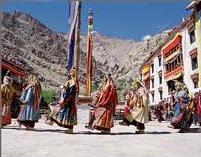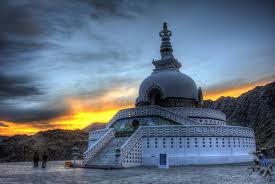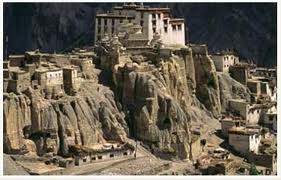Monasteries of Ladakh
Then there are the Buddhist monasteries (Gompa), treasure troves of images and artifacts, of which about a dozen are situated on or near the Indus River. Upstream of leh are the monasteries of Thiksey, Stakna, Hemis, Chemrey, Takthok, Matho, Phyang, Likir, Alchi, Rizong and Lamayuru
Hemis Gompa
The Hemis  Gompa is the biggest monastery in Ladakh. Located 45 Km to the south of Leh. Hemis Gompa was built in 1630 and houses monks of the Brokpa or Red Hat sect. Tourists can see beautiful frescoes (paintings) on the walls and the largest Thangka painting in Ladakh, which is over 12 m in length. The Hemis Gompa is famous for its annual Tse Chu Festival held in June-July, which is characterized by colorful masked dances. The festival commemorates the anniversary of Padmasambhava, the founder of Tibetan Buddhism. Dancers wearing brightly colored masks that represent good and evil characters in Mahayana Buddhism, enact an age-old tale of the victory of good over evil. The Hemis Festival also includes a vibrant bazaar where craftsmen sell handcrafted items.
Gompa is the biggest monastery in Ladakh. Located 45 Km to the south of Leh. Hemis Gompa was built in 1630 and houses monks of the Brokpa or Red Hat sect. Tourists can see beautiful frescoes (paintings) on the walls and the largest Thangka painting in Ladakh, which is over 12 m in length. The Hemis Gompa is famous for its annual Tse Chu Festival held in June-July, which is characterized by colorful masked dances. The festival commemorates the anniversary of Padmasambhava, the founder of Tibetan Buddhism. Dancers wearing brightly colored masks that represent good and evil characters in Mahayana Buddhism, enact an age-old tale of the victory of good over evil. The Hemis Festival also includes a vibrant bazaar where craftsmen sell handcrafted items.
Shanti Stupa
(Entry Free. Timings: 5 a.m.-9 p.m.) The Shanti Stupa is an impressive white-domed structure in Chandspa that is beautifully illuminated at night. It was built by a Japanese Buddhist organization to commemorate 2500 years of Buddhism and to promote World Peace. The Shanti Stupa was inaugurated by His Holiness the Dalai Lama in 1985. You can approach the monastery by a steep flight of steps or by a 3 Km route from theFort Road. The views of the sunset and sunrise from the Shanti Stupa are spectacular.
The Shanti Stupa is an impressive white-domed structure in Chandspa that is beautifully illuminated at night. It was built by a Japanese Buddhist organization to commemorate 2500 years of Buddhism and to promote World Peace. The Shanti Stupa was inaugurated by His Holiness the Dalai Lama in 1985. You can approach the monastery by a steep flight of steps or by a 3 Km route from theFort Road. The views of the sunset and sunrise from the Shanti Stupa are spectacular.
Sankar Gompa (Prayer Timings 7 – 8:30 a.m)
Situated 2 Km North of the city center, the Sankar Gompa houses monks of the Gelukpa or Yellow Hat order. It has a grand image of Avalokiteshvara (The Buddhist deity of compassion) who is depicted with 1,000 heads and 1,000 arms.
Alchi Gompa
The Alchi Gompa is situated on the bank of the River Indus and is easily accessible since it is the only Gompa in Ladakh, which is located on flat ground. Founded by Ringchen Zangpo, the Great Translator, the Alchi Gompa displays a Kashmiri influence in its art and architecture. Within the monastery you can see many beautiful images of Buddha. Photography is not permitted within the Alchi Monastery.
Likir Monastery
The Likir Monastery is also called the Klu-Kkhjil or “water spirits” gompa and is situated 52 Km from Leh. Built over an earlier Gompa burnt down in the 15th century, the present Gompa is an 18th century construction and houses monks of the Gyalukpa sect. The Likir monastery has a rich collection of paintings, robes and artifacts. The Likir Festival is held from the 17th to 19th of the 12th month of the Tibetan Buddhist calendar.The Leh Palace is a smaller version of the Potala Palace in Lhasa, the capital of Tibet. Built in the 17th century for King Singge Namgyal, the Leh Palace was the residence of the Ladakhi royal family till they were sent into exile in Stok in the 1830s. Now undergoing reconstruction the Leh Palace also houses the Ladakh office of the archeological conservation organization of the Indian Government.
Stok Palace
(Entry Fee: Rs 25, Timings 8 a.m. – 7p.m.) The Stok Palace is located on a glacial deposit of pebbles and overlooks fields of barley grown on terraces on the mountains. Standing four storeys tall, the Stok Palace was the official residence of the royal family of Ladakh and was constructed in 1814 by Ladakh’s last ruler. The museum at the Stok Palace has an intriguing collection of Buddhist art, weapons, jewelry and artifacts, including thangkas painted with colors derived from crushed precious stones. Also on display are the ceremonial headdresses or ‘peraks’ of the erstwhile rulers of Ladakh. These headdresses are decorated with turquoise, lapis lazuli and coral and gold, making them an exotic sight.
Lamayuru Monastery
The Lamayuru monastery is located on a high rocky outcrop, which overlooks a valley and the village of Lamayuru, 125 Km west of Leh. It is also called the Yung Drung or Swastika monastery and its stunning location makes this monastery a must visit on a tour to Ladakh. The monastery has a many Thangka paintings in its main hall. The annual festival of Lamayuru Monastery is held every summer on the 28th and 29th days, of the 2nd month of the Tibetan Buddhist calendar.
is located on a high rocky outcrop, which overlooks a valley and the village of Lamayuru, 125 Km west of Leh. It is also called the Yung Drung or Swastika monastery and its stunning location makes this monastery a must visit on a tour to Ladakh. The monastery has a many Thangka paintings in its main hall. The annual festival of Lamayuru Monastery is held every summer on the 28th and 29th days, of the 2nd month of the Tibetan Buddhist calendar.
Shey Monastery
Situated on a hillock 15 km south of Leh, Shey Gompa was previously the summer palace of the Ladakhi kings. A prince of Ladakh installed the 12 m tall gold-plated copper statue of Sakyamuni Buddha, which can be seen here. The Shey Gompa celebrates its annual festival on the 30th day of the 1st month of the Tibetan Buddhist calendar.
Spituk Monastery
The Spituk Gompa is perched on a high hill overlooking the Indus river about 18 Km from Leh. Rinchen Zangpo the Great Translator who helped spread Buddhism in Ladakh named the monastery. (Spituk means exemplary). The Spituk monastery is known for its collection of Buddhist artifacts and for the Spituk festival held from the 17th to 19th days of the 11th month of the Buddhist calendar. Further up the hill is a Mahakal Temple, where a fearsome image of Vajrabhairava is unveiled once a year at its annual festival.
Thiksey Monastery
The Thiksey monastery  located 17 Km from Leh is 12 storeys high and has many statues of Buddha, a pillar inscribed with Buddhist teachings, a 15 m high seated Maitreya Buddha in the main prayer hall, and a vast collection of Buddhist art. Home to monks of the Gelukpa order the Thiksey monastery is known for its annual festival held from the 17th to 19th day of the 12th month of the Tibetan Buddhist calendar.
located 17 Km from Leh is 12 storeys high and has many statues of Buddha, a pillar inscribed with Buddhist teachings, a 15 m high seated Maitreya Buddha in the main prayer hall, and a vast collection of Buddhist art. Home to monks of the Gelukpa order the Thiksey monastery is known for its annual festival held from the 17th to 19th day of the 12th month of the Tibetan Buddhist calendar.







 1
1 2
2 3
3 4
4 5
5 6
6 7
7